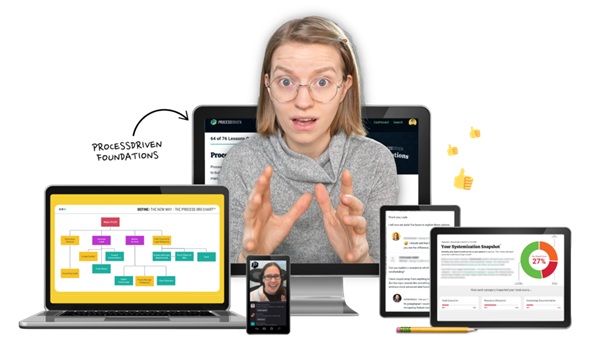No products in the cart.
[GroupBuy] ProcessDriven Foundations – Layla
$1,497.00 $32.00
- Payment method: I will send the payment link to your email.
- Deliver by: Google Drive, Mega.nz
Category: Marketing
Process improvement foundations are crucial for any small team looking to boost productivity and achieve sustainable growth. This article explores the core principles of establishing a robust process-driven system, highlighting practical strategies and solutions for overcoming common inefficiencies.
Table of Contents
Process Improvement Foundations
Many small teams grapple with inefficiency and disorganization, despite their best intentions and efforts to implement effective systems. They invest in new software, hire consultants, and download templates, yet still struggle to achieve lasting improvements. The problem isn’t a lack of desire but a lack of practical guidance on how to build processes that actually work. This section will dive into the core challenges teams face and how process improvement foundations, specifically, can provide a solution.
The “How-To” Gap in Systemization
Popular business books like “Scaling Up,” “Traction,” “Clockwork,” and “Built to Sell” emphasize the importance of processes and systems. They make a compelling case for why systemization is essential for growth, scalability, and overall success. However, they often fall short in providing concrete, actionable steps on how to actually build these processes. They present the theory, but leave teams struggling to translate that theory into practice.
This lack of practical guidance creates a significant gap. Teams are left searching for conflicting advice online, experimenting with different approaches, and ultimately becoming overwhelmed and discouraged. They might try to implement a new CRM, adopt a project management tool, or create a set of standard operating procedures (SOPs), but without a clear understanding of how these elements fit together into a cohesive system, their efforts often fall flat. They spend valuable time and resources on solutions that don’t address the root cause of their inefficiency. ProcessDriven’s stance is clear: business books provide the why, and process improvement foundations provides the how.
This isn’t to say that these business books are without merit. They provide valuable insights into the importance of systemization and the benefits it can bring. However, they are often best suited for larger organizations with dedicated process improvement teams. Small teams, with limited resources and expertise, need a more hands-on, practical approach. They need a framework that provides step-by-step guidance, clear examples, and actionable templates that they can adapt to their specific needs. The process improvement foundations fill this gap by providing a practical, actionable system-building methodology tailored for small teams.
The Pitfalls of Band-Aid Solutions
Teams often resort to quick fixes and band-aid solutions in their quest for improved productivity. They might change to the “next great software,” hoping that a new tool will magically solve their problems. They might hire consultants who provide generic advice and homework, but lack a deep understanding of the team’s specific challenges and workflows. They might download templates that lack customization and relevance, or try DIY process improvement with YouTube tutorials, leading to overwhelm and conflicting information.
These band-aid solutions often fail because they ignore the root problem: bad habits and inefficiencies within the team’s work management processes. Simply switching to a new software without addressing underlying issues will only result in the same problems surfacing in a different environment. Hiring a consultant who provides generic advice without tailoring it to the team’s specific needs will likely lead to a disconnect between recommendations and implementation.
The key takeaway is that teams don’t need “process hacks you can swipe.” They need a lasting process strategy that their team can actually implement. This requires a fundamental shift in mindset, from seeking quick fixes to investing in a sustainable system that addresses the root causes of inefficiency. It’s about building a culture of continuous improvement, where team members are empowered to identify and address process bottlenecks, and where systems are designed to support their work, not complicate it. Process improvement foundations focus on this lasting strategy.
Focus on Practical, Actionable System Building
Process improvement foundations provide a plug-and-play framework designed to help teams restructure their tasks, document team knowledge, and define their key company processes. It’s about moving away from reactive, ad-hoc workflows to a proactive, systemized approach. The aim is to empower teams to take ownership of processes and create a culture of accountability and continuous improvement.
This framework offers a structured approach to systemization, breaking down complex processes into manageable steps. It provides clear templates, practical examples, and actionable guidance that teams can immediately implement. Instead of getting bogged down in theoretical concepts, teams can focus on building practical systems that address their specific needs and challenges. The program is presented as bite-sized and digestible content, making it easy for team members to learn and apply the concepts. This allows them to immediately implement what they are learning and see tangible results, such as reduced meeting times, fewer Slack messages, and increased productivity.
The practical focus extends to all aspects of the program, from task management to SOP writing to delegation of responsibility. Teams learn how to restructure their tasks so that they don’t need constant meetings or Slack messages to stay informed. They learn how to document team knowledge into SOPs so that they can take unplugged vacations without worrying about things falling apart. And they learn how to define their key company processes so that they can delegate responsibility instead of constantly chasing tasks. Process improvement foundations is the bedrock upon which efficient teams are built.
Watch Process Improvement Foundations Videos
The limitations of traditional learning methods often lead to frustration and wasted effort. Many teams struggle to translate theoretical knowledge into practical application. Watching process improvement foundations videos can provide a more engaging and effective way to learn and implement these principles. This section will explores the benefits of visual learning and how ProcessDriven Foundations™ utilizes video content to deliver a more accessible and impactful learning experience.
Work Management Software Integration and Tool-Agnostic Philosophy
While process improvement foundations provides templates for specific software like ClickUp, SmartSuite, and Notion, the underlying methodology is designed to be largely software-agnostic. The focus is on the principles of process optimization, not on the specific features of a particular tool. The approach to building systems to boost team productivity is designed to work in any software with basic task management and relationship features.
This flexibility is crucial because it allows teams to apply the principles of process improvement foundations regardless of the software they are currently using. They don’t need to switch to a new tool in order to benefit from the program. Instead, they can leverage their existing software and learn how to use it more effectively to support their processes. The program’s compatibility is explicitly stated for Airtable and Trello (DIY setup required), highlighting the adaptability of the methodology. However, it also acknowledges that certain software, such as Asana, Microsoft To Do, Todoist, or Wrike, may lack the necessary features to fully implement the framework.
This tool-agnostic philosophy allows teams to focus on the core principles of process optimization without getting bogged down in the technical details of a specific software. It emphasizes that the software is simply a tool to support the processes, not the other way around. By focusing on the underlying principles, teams can create systems that are adaptable, scalable, and sustainable, regardless of the software they are using. Watching process improvement foundations videos can further illustrate these principles.
Ideal Target Audience and Value Proposition
The ideal client for process improvement foundations is an established company or non-profit with a team of 3 to 30 members. This includes departments or divisions within larger companies that have autonomy over their daily workflow and tool usage. The program is specifically designed for teams that sell or do the same things again and again and whose work should be predictable and easy, but isn’t. It’s for teams that are struggling with inefficiency, disorganization, and a lack of clear processes.
However, the program is not for individuals (1-person businesses or personal productivity), startups less than 2 years old lacking product-market fit, users only interested in software setup (it’s a systemization program, not a software tutorial), those seeking a magic wand or unwilling to invest time, employees without buy-in from their manager (requires a team-based approach), or systems service providers intending to resell the approach. These exclusions are important because they ensure that the program is targeted at the right audience and that participants have the necessary commitment and resources to succeed.
The value proposition of process improvement foundations is clear: it offers a proven methodology, tangible ROI, and significant time savings. The program claims to deliver results in a few hours versus wasting $66,000 in salary to try to DIY over 8 months. It earns credibility through results, not certifications, and demonstrates expertise through its YouTube channel. These factors contribute to the program’s appeal and its ability to attract a specific target audience.
Learning Through Video Content
Video content offers a unique advantage in learning and implementing process improvement foundations. Visual demonstrations, real-world examples, and step-by-step tutorials can significantly enhance understanding and retention. Concepts that might seem abstract or complex when presented in text become much clearer when illustrated visually.
ProcessDriven Foundations™ leverages this advantage by incorporating a wide range of video content into its curriculum. The videos provide practical demonstrations of how to apply the principles of process improvement foundations in different scenarios. They showcase real-world examples of how teams have successfully implemented the framework and achieved tangible results. And they offer step-by-step tutorials on how to use specific software tools to support the processes.
This visual learning approach is particularly beneficial for teams that are new to systemization or that have struggled to implement traditional training methods. The videos make the learning process more engaging, accessible, and memorable. They allow team members to see the concepts in action and to understand how they can be applied to their own work. Moreover, the ability to pause, rewind, and re-watch the videos allows learners to pace themselves and to review the material as needed. Watch process improvement foundations videos for a comprehensive understanding.
Credibility Through Results, Not Certifications and Creator & Coach Expertise
Process improvement foundations avoids relying on third-party certifications to prove its expertise. Instead, it focuses on demonstrating tangible results and building credibility through a strong online presence. The program boasts a measurable ROI and claims of significant time savings for its participants. These concrete outcomes speak volumes about the effectiveness of the methodology.
The program’s credibility is further enhanced by the expertise of its creators and coaches. Layla (CEO & Creator, systemizing since 2018) and Sarah (Coach & Curriculum, 16+ years in education, successfully applied Foundations to a school) bring a wealth of experience and knowledge to the program. Their backgrounds in systemization and education ensure that the content is both practical and pedagogically sound.
This combination of tangible results, creator expertise, and a strong online presence establishes process improvement foundations as a credible and trustworthy resource for teams seeking to improve their productivity and efficiency. It’s a testament to the program’s commitment to delivering real value and empowering teams to achieve lasting success.
| Feature | Description |
|---|---|
| Core Problem Addressed | Widespread inefficiency and messy moments experienced by small teams, despite good intentions. |
| Solution | ProcessDriven Foundations™ – A self-study program teaching teams to build a sustainable productivity system. |
| Key Focus | Practical application over theoretical knowledge; task management, SOP writing, and delegation. |
| Tool Philosophy | Largely software-agnostic; templates for ClickUp, SmartSuite, and Notion, compatible with Airtable and Trello. |
| Target Audience | Established companies/non-profits with 3-30 members, departments within larger companies with workflow autonomy. |
| Ideal Client Characteristics | Teams that perform repetitive tasks and whose work should be predictable but isn’t. |
| ROI Claim | Measurable ROI (e.g., 75x ROI within a week). |
| Time Savings | Delivers results in hours vs. months of DIY efforts. |
| Credibility Source | Results-driven; avoids reliance on certifications; strong YouTube presence. |
| Expertise | Developed by Layla (CEO & Creator) and Sarah (Coach & Curriculum). |
| Learning Method | Watch process improvement foundations videos for a comprehensive understanding. |
Conclusion
In conclusion, process improvement foundations offer a structured and practical approach to addressing the widespread inefficiencies experienced by small teams. By focusing on actionable system building, integrating with existing work management software, and targeting the right audience, ProcessDriven Foundations™ provides a pathway to sustainable productivity. Unlike traditional methods that often fall short, this methodology emphasizes tangible results, creator expertise, and accessible learning through methods like watch process improvement foundations videos, empowering teams to transform from a state of chaos into highly efficient organizations.
Sales Page:_https://processdriven.co/services/pf/
Delivery time: 12 -24hrs after paid
Be the first to review “[GroupBuy] ProcessDriven Foundations – Layla” Cancel reply
Related products
$39.00
$19.00











Reviews
There are no reviews yet.